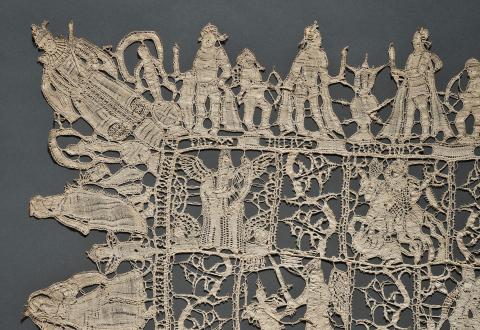The Lace & Costume collection (about 8,000 and 3,000 pieces respectively) is not exhibited in its entirely or on display in a separate room. However, parts of it can be seen in the renovated rooms dedicated to the decorative arts of the 18th century and pieces are regulary lent for temporary exhibitions in other museums.
Bedspread depicting Archduke Albert and Isabella
This bobbin-lace bedspread was given to Archduke Albert and Isabella who governed our regions from 1598 to 1633. Some of the 120 squares portray the couple and the ruling families related to them. Others depict subjects drawn from the Ommegang, a sacred and profane pageant whose floats represented a summary of popular life in the Duchy of Brabant. At that time, the lace industry, still in its infancy, was limited to braided geometric patterns. The variety of themes represented here - and the technical innovations that consequently had to be implemented - make this bedspread an exceptional...
This bobbin-lace bedspread was given to Archduke Albert and Isabella who governed our regions from 1598 to 1633. Some of the 120 squares portray the couple and the ruling families related to them. Others depict subjects drawn from the Ommegang, a sacred and profane pageant whose floats represented a summary of popular life in the Duchy of Brabant. At that time, the lace industry, still in its infancy, was limited to braided geometric patterns. The variety of themes represented here - and the technical innovations that consequently had to be implemented - make this bedspread an exceptional piece. It foreshadows the perfection and originality of a regional industry whose reputation remained strong until the dawn of the 20th century.

The train of Queen Marie Henriette
Several days of festivities were held in Brussels to mark the silver wedding anniversary (25 years of marriage) of Léopold II and Marie Henriette. One of the highlights of the celebrations took place at the Royal Palace in Brussels on the evening of 23 August 1878, when the Queen was presented with a tiara adorned with precious stones, and a lace train. This magnificent train was financed by a national subscription among Belgian women. It was presented to the Queen by female delegates from the nine Belgian provinces, in the presence of 2,300 female representatives of the country’s...
Several days of festivities were held in Brussels to mark the silver wedding anniversary (25 years of marriage) of Léopold II and Marie Henriette. One of the highlights of the celebrations took place at the Royal Palace in Brussels on the evening of 23 August 1878, when the Queen was presented with a tiara adorned with precious stones, and a lace train. This magnificent train was financed by a national subscription among Belgian women. It was presented to the Queen by female delegates from the nine Belgian provinces, in the presence of 2,300 female representatives of the country’s municipalities. This explains why sprays and garlands of flowers blossom on a cluster of Belgian lions between the coats of arms of the nine provinces. The shell-shaped train is scattered with bobbinwork Belgian lions of an increasing size, applied alternatively to the right and the left. At the bottom, the nine coats of arms of the Belgian provinces are applied with a bobbin, from left to right: Luxembourg, Limburg, Hainaut, Liège, Brabant, Antwerp, Namur, West Flanders and East Flanders.

Contact
Ria Cooreman
r.cooreman@kmkg-mrah.be